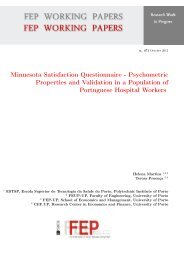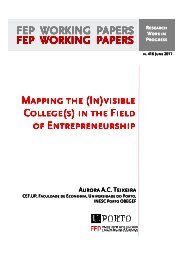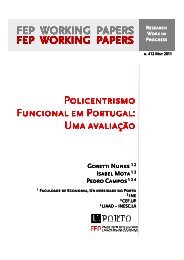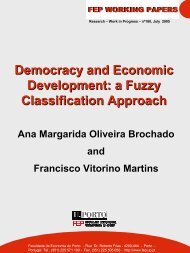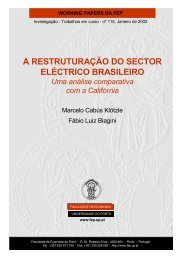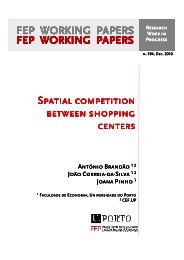Ant Colony Optimization: a literature survey - FEP - Working Papers
Ant Colony Optimization: a literature survey - FEP - Working Papers
Ant Colony Optimization: a literature survey - FEP - Working Papers
Create successful ePaper yourself
Turn your PDF publications into a flip-book with our unique Google optimized e-Paper software.
(Crawford and Castro, 2006), and even with Genetic Algorithms as is the case of (Altiparmakand Karaoglan, 2007). This allowed ant algorithms to achieve even better results in problemstoo complex to be solved by a single heuristic method.In the following section we will explore, in detail, the first ant algorithm, that was called the <strong>Ant</strong>System. Afterwards, we review some of the large number of interesting works that have beendeveloped ever since. We focus our attention mostly in works that have introduced modificationsand extensions to the so-called building blocks of ACO algorithms. This is made with thepurpose of showing alternative methods, that worked well with specific optimization problems,so that the reader who is developing an ACO algorithm can easily perceive its utility and howto adapt it for the problem at hand.2 <strong>Ant</strong> <strong>Colony</strong> Principles<strong>Ant</strong> <strong>Colony</strong> <strong>Optimization</strong> principles are based on the natural behaviour of ants. In their dailylife, one of the tasks ants have to perform is to search for food, in the vicinity of their nest.While walking in such a quest, the ants deposit a chemical substance called pheromone in theground. This is done with two objectives. On the one hand, it allows ants to find their way backto the nest, such as Hansel and Gretel in the fairytale. And on the other hand, it allows otherants to know the way they have taken, so that the others can follow them. The curiosity is that,because hundreds or even thousands of ants have this behaviour, if one could see the pheromonelaid in the ground as a kind of light, the ground would be a large network with some of the arcsbrighter than the others. Within the paths created by those arcs would surely be the shortest pathbetween the nest and the food source. This behaviour can be seen as a kind of communicationbetween the ants. If the path has a large concentration of pheromone, this is probably due to itsshorter length that allowed ants to travel faster, resulting in a larger number of travels throughthe path therefore with much more ants depositing pheromone on it. Furthermore, over timethe pheromone evaporates and thus its concentration reduces. The more time it takes for the antto travel from the nest to the food source and back to the nest, the more time the pheromoneshave to evaporate. This system is thus based both on the positive feedback, i.e. depositing ofpheromone attracts other ants to use the same path which will increase the pheromone quantity,and on negative feedback, i.e. dissipating of the pheromone through evaporation leads tolower levels of pheromone thus discouraging other ants. Deneubourg et al (1990) and Goss et al(1989) performed some experiences with real ants and they where able to show that foragingants can find the shortest path between their nest and some food source, by the use of a chemicalsubstance called pheromone, that they deposit while walking. After these experiments theauthors proposed a stochastic model to describe what they had observed. This was the first stepleading to an optimization algorithm based on the foraging behaviour of ants. Some years later,Dorigo et al (1996) developed the first foraging ants algorithm which was called <strong>Ant</strong> System and3



